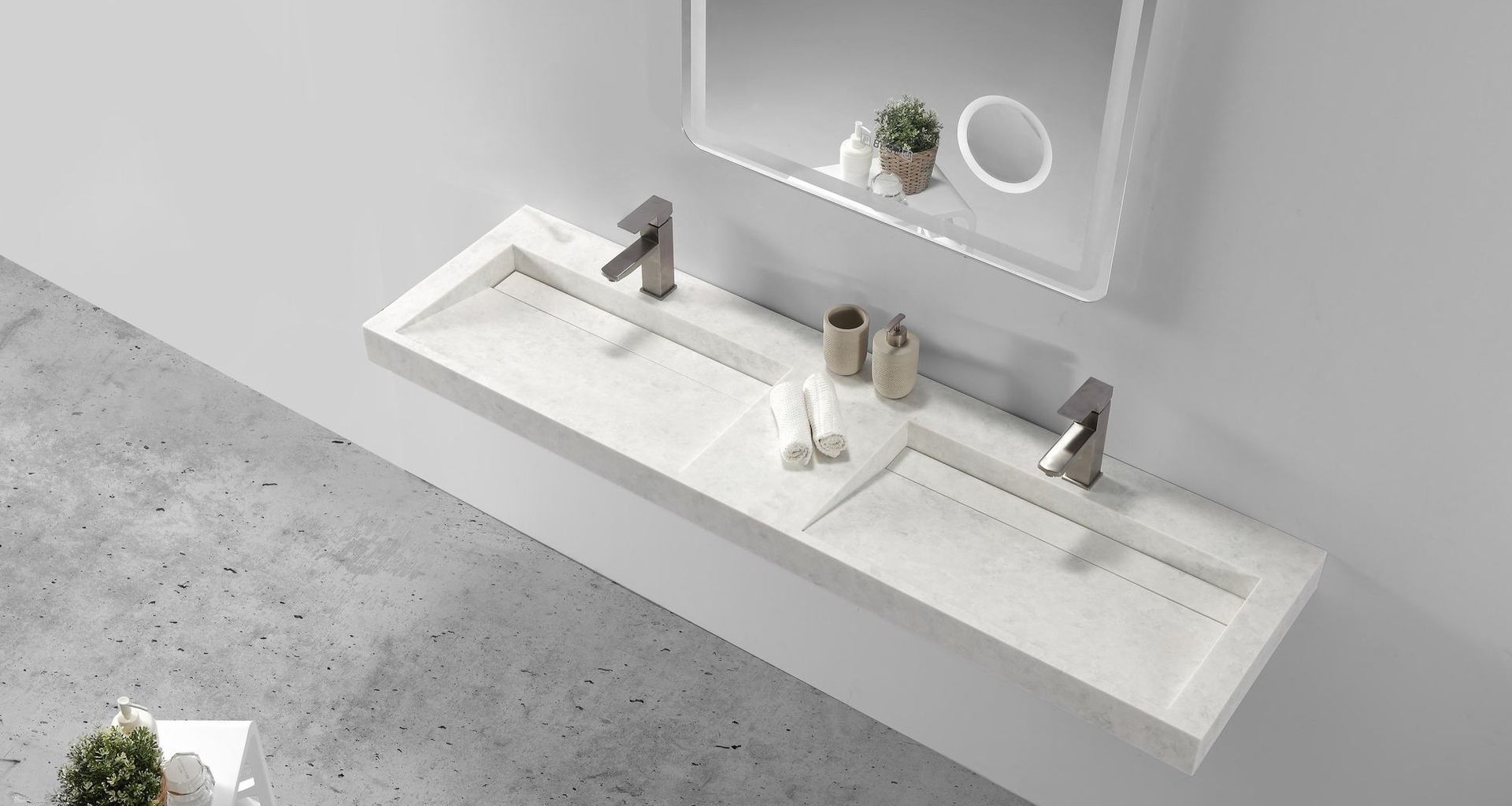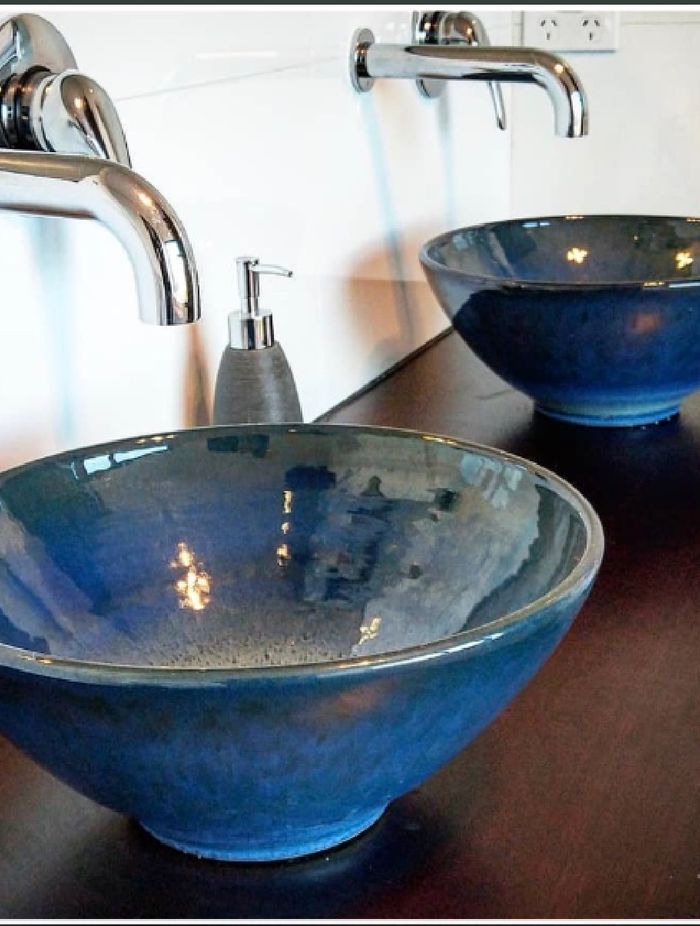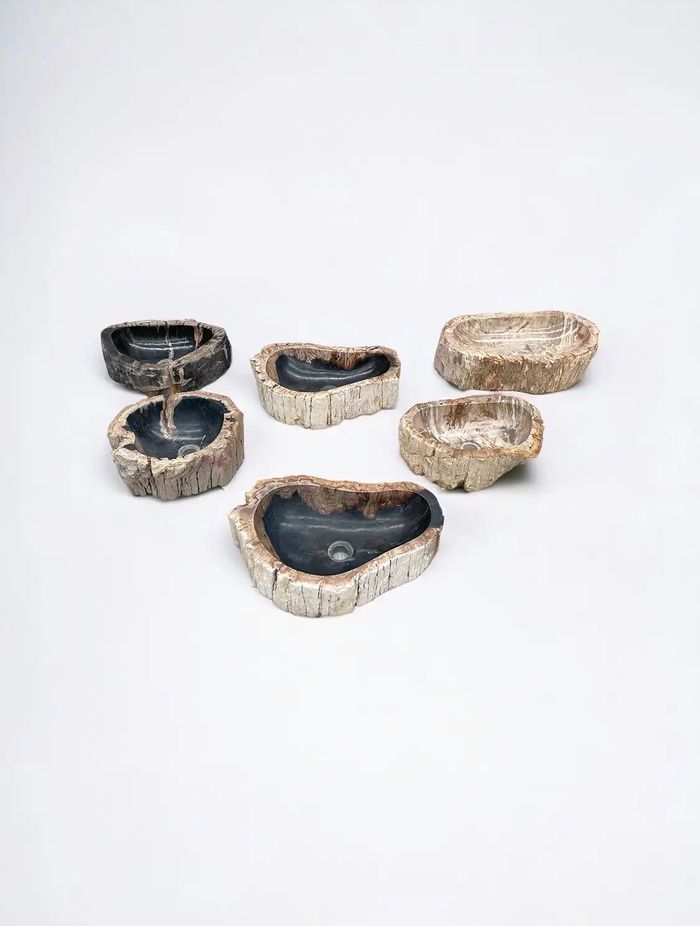Popular bathroom sink materials: A breakdown of pros and cons
Written by
27 June 2022
•
6 min read

Understanding bathroom sink materials' pros and cons is extremely important, as it's a choice that impacts many other factors. Materials influence aesthetic style, durability and longevity, price and availability, ease of installation, and costs — the list goes on. Knowing the ins and outs of all the main bathroom sink materials available in Australia today, you are best placed to make a decision that works best for you.
1. Ceramic sinks
Ceramic bathroom sinks are one of the most popular types in Australia and around the world. Essentially, ceramic is a type of pottery that can be formed into many different sink shapes. After getting moulded, it gets fired at high temperatures, where it hardens, giving a smooth, sleek finish.
Pros
- The surface of the sink is smooth and waterproof
- The non-porous surface is stain-resistant and easy to clean
- They are affordable
- They come in a variety of shapes and styles
Cons
- Harsh chemicals can scratch the surface
- They can shatter or crack with heavy hits or pressure

2. Acrylic sinks
Acrylic is a tough material that can withstand the rigours of daily bathroom use. It can be easily moulded into any shape and size, meaning there are many different designs and styles to choose from. It is also an incredibly lightweight material, making it easy to work with for builders, plumbers, or DIY specialists.
Pros
- Acrylic sinks come in a wide variety of shapes and sizes
- They are lightweight for easy installation
- Scratches can be buffed out
Cons
- Acrylic can scratch more easily compared to other materials
- Abrasive cleaners and materials may scratch the surface
3. Stainless steel sinks
Stainless steel is an eco-friendly material for bathrooms. It is 100% recyclable and perfect for modern home renovations. Strong and robust, stainless steel is more frequently seen in kitchens and laundry rooms but is starting to find its way into Australian bathrooms as well.
Pros
- Stainless steel is an eco-friendly material
- It is stain-resistant and easy to clean
- It prevents bacteria growth
- Stainless steel sinks are durable and hold up to everyday use
Cons
- They are considered a modern style in bathrooms, which may not suit all
- There are different grades of stainless steel, and some can dent easily
4. Porcelain sinks
Porcelain is another pottery-type sink material, very similar to ceramic. Slightly more durable than ceramic, porcelain is also usually available in a variety of different colours giving you some great options for interior styling.
Pros
- Porcelain is a low-maintenance material and is easy to clean
- Porcelain is non-porous and won’t absorb water
- Porcelain sinks have a good reputation for long-term use
Cons
- Porcelain is prone to chipping
- Porcelain can stain when exposed to chemicals or colours
- Porcelain sinks are heavy and more challenging to install than other materials
Related article: What bathroom sinks are in style? Our top picks

5. Natural stone sinks
Natural stone sinks come from slabs or blocks of stone and are sculpted to make a sink bowl shape. Each sink is unique because of the natural variations of the material and the carving process. When done well, they can look exceptionally stylish.
Pros
- Natural stone is resistant to high temperatures
- Each piece is unique and gives an organic feel to your space
- They are easy to clean
Cons
- Natural stone sinks need to have sealer applied at least twice a year
- They are difficult to install without a bathroom professional


6. Glass sinks
Tempered glass sinks are stylish and strong solutions that never fail to catch the eye. They come in various styles and are typically extremely artistic and expressive.
Pros
- Glass sinks do not require a lot of maintenance
- Glass sinks are available in many colours and styles
- They are easy to clean using glass cleaner
- Tempered glass is shatter-resistant
Cons
- They are susceptible to breaking with heavy use
- The glass needs to get wiped dry often to prevent mineral buildup
7. Wood sinks
Wood is becoming an increasingly popular material for those who want to include elements of nature in their bathroom space. Vessel sinks, in particular, are a great way to showcase the grain and colour of wood, bringing warmth and beauty.
Pros
- Wood sinks are eco-friendly
- They are very unique, creating warmth while enhancing themes of nature
- Some species, like Teak, are resistant to mildew and mould buildup
Cons
- Wood sinks need to be cleaned and dried regularly
- They need to be sealed before use
- Scouring materials can damage the surface so care needs to be taken with products used

8. Copper sinks
Copper sinks are another uniquely stunning, eco-friendly choice. Perfect for industrial-styled bathrooms, they can be incorporated into other designs as a featured focal point.
Pros
- Copper is a long-lasting material that is resistant to staining and rust
- Copper is antimicrobial, making it a perfect material for the bathroom
- Copper sinks come in many styles to match your bathroom design
Cons
- Copper sinks can be expensive depending on the style and craftsmanship
- Professional help is nearly always required for installation
- Copper needs extra care to avoid patina
- Reacts to acidic food and chemicals

9. Solid surface sinks
Solid surface sinks are a comparatively recent addition to the market in Australia. They are a type of sink moulded from a mineral compound with resin, leaving no seams. This material is frequently used for undermount sinks and drop-in sinks.
Pros
- The sink is seamless so it is easy to keep clean and sanitised
- Made of materials that mimic more expensive sink materials like stone
- It is easy to buff out surface scratches
- Holds up well to daily wear and tear
Cons
- The softer surface can scratch and dent
- Spills that are left may leave stains on the sink surface
- Solid surface sinks are not heat-resistant
10. Concrete sinks
Concrete sinks have become very popular in recent years because of the unique and striking qualities they bring. Concrete is versatile and can be custom-made into many different styles to match your bathroom. Heavy and durable, they will add an undeniable presence to your designer bathroom.
Pros
- Concrete is durable and not easy to damage with daily use
- Concrete is an affordable alternative to natural stone sinks
- They do not need much maintenance with proper care
- Concrete sinks can be moulded into a wide variety of colours and shapes
Cons
- You will not get a flawless finish with a concrete sink
- Concrete is porous and needs to be sealed to prevent staining
Related article: Bathroom sink ideas for Australian bathrooms

The pros and cons of bathroom sink materials
Now that you know the most popular bathroom sink materials' pros and cons, you can start planning your project with confidence. Each type of sink has unique qualities and features and some will naturally appeal more to you than others. Knowing what you want to achieve with your bathroom basin will help you make the right choice for your bathroom with style.
This article has been updated on 12th December 2024
Browse high-quality bathroom sinks made with the finest materials on ArchiPro